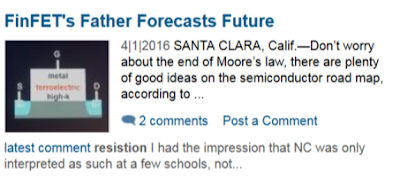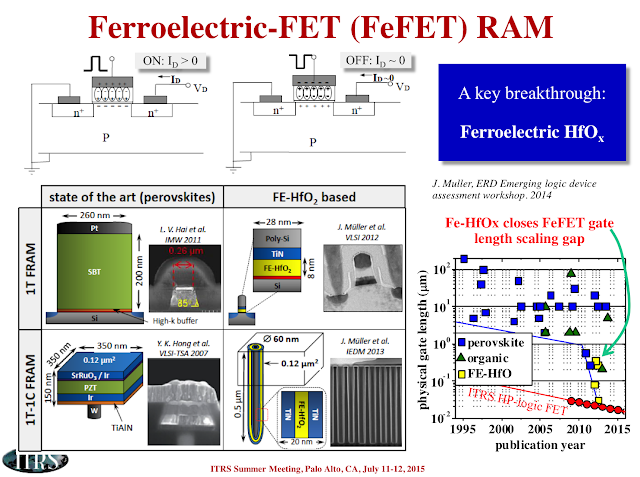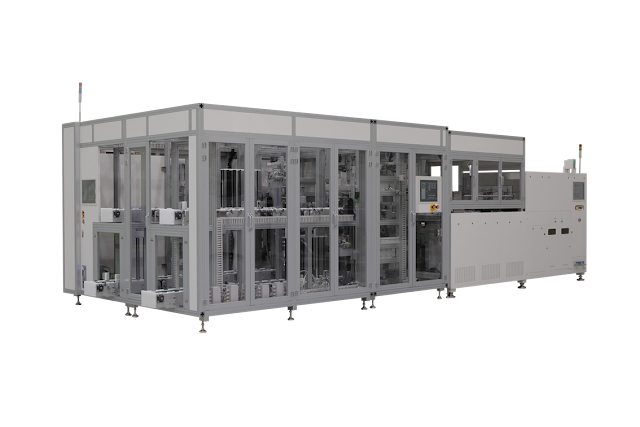Here is an interesting story in EETimes on how "The Father of FinFET" Prof. Chenming Hu at Berkeley Device Modeling Center is promoting the Negative Capacitance Field efefct Transistor (NC-FET) based on a ferroelectric Hafnium Zirconium oxideintegrated into a standard HKMG Stack. The presenatation was hels as a Key Note "What Else Besides FinFET?" at the SNUG Silicon Valley 2016 · March 30 –31 · Santa Clara Convention Center organized by Synopsys.
The gate stack under investiogation is a conventional thin HfO2 gate oxide with an added 5 nm ferrorelctric ZrO2:HfO2 layer before gate processing, which is a process that could be realized in anz sub 45 nm Fab today assuming you can etch a "thick" high-k gate oxide. The NC-FET development is supported by Intel and TSMC who joined joined, paying $140,000 each.
 |
| http://www.eetimes.com/document.asp?doc_id=1329333& |
The gate stack under investiogation is a conventional thin HfO2 gate oxide with an added 5 nm ferrorelctric ZrO2:HfO2 layer before gate processing, which is a process that could be realized in anz sub 45 nm Fab today assuming you can etch a "thick" high-k gate oxide. The NC-FET development is supported by Intel and TSMC who joined joined, paying $140,000 each.
Chenming Calvin Hu is Distinguished Professor of Microelectronics at University of California, Berkeley. From 2001-2004, he was the Chief Technology Officer of TSMC, world’s largest IC foundry. (Wikipedia.org)
You have followed this Blog may have come across previos stories on the discovery and research on ferroelectric Hf-based metal oxides conducted in Dresden, German by NaMLab, Fraunhofer and Globalfoundries. Below is a small collection of those posts. One of the first materials systems besides Si:HfO2, Al:HfO2 and Y:HfO2 was the ZrO2:HfO2 system investigated by Johannes Müller (Fraunhofer IPMS). If this constallation also hare covering NC-FET, besides the work on FE-FETs and FRAM is not known. In any case, it will be continiously interesting to follow the forgress of ferroelectric ALD HfO2 based materials for novel devices!
Dresden Memory Startup To Debut At Semicon Europa
FMC has been formed by NaMLab to commercialize the work and has taken over a publicly-funded program that will provide €500,000 (about $565,000) to cover development over the period April 2015 to September 2016. Meanwhile the small group of engineers that have formed the company are looking for early-stage investment and potential partners, Mueller said.
Full story at EETimes : http://www.eetimes.com/document.asp?doc_id=1327699&page_number=1
Ferroelectric HfO2 by ALD Key Breakthrough in ITRS “Beyond CMOS” Update 2015
Ferroelectric HfO2 Based Materials and Devices: Current Status and Future Prospects
Qimonda’s late legacy: 28nm FeRAM using ALD Ferroelectric HfO2
“This research goes back to 2007 at DRAM maker Qimonda, when a PhD candidate Tim Böscke was doing research to improve HfO2 as a high-k dielectric for capacitors in dynamic random access memories, using dopants to stabilize the material”, explained Mikolajiick. “At certain dopant concentrations and under specific treatments, Böscke noticed that strange peaks occurred in the CV characteristic of the material, and that it behaved as a ferroelectric. This was totally unexpected!"



%20(1).png)






